It’s amazing when a plan comes together and goes better than you imagined. That’s what happened this past Sunday, March 19, 2023, when firefighters from three nearby areas came to our farm and executed a controlled burn on one of the two houses. In less than two hours, it completely burned to the ground, yet the planning and preparation had been in the works for 4 ½ years, since the Fall of 2017.
You may wonder why we would demolish a home, especially one that:
- Was a landmark on our historic farm and rich in history
- Was my husband’s childhood home
- Served as a temporary home to our family from June – October 2021, while we waited for the remodel next door to be complete
Let me explain
My husband’s family farm is nearly 200 years old. It has been passed down from father to son for six generations. During those generations, several homes were constructed on the property.
The original home was a log cabin. Then in 1854, the home we’re talking about was built (pictured below in 1910). It was the home of my husband Tom’s great-great-great-grandfather.
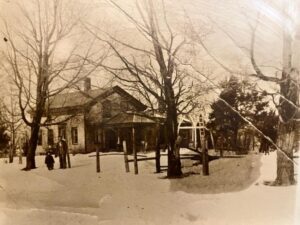
Later, in 1911, Tom’s great-grandfather built another house on the property right next door — the home we remodeled and restored in 2021 and live in now.
As the generations aged, our home became Tom’s grandparents home. The house built in 1854 is where Tom’s dad and mom raised their family. Talk about bittersweet for Tom and his brother and sister. They all watched on Sunday as the fire consumed their childhood home.
Sad, but good
For some, that might seem unthinkably sad. But for us, it was both necessary and good.
‘Necessary’ because the home was beyond repair. It was not a fixer-upper. Far too much money would be required to bring it back to life and make it livable again. Yes, we lived in it as recently as 2021 (when it looked like the picture below), but it was tough. You can read about our adventures in another blog post. We made it work because it was temporary, but it has outlived its purpose as a family dwelling. The roof was rotten, floors were rotten, the foundation was crumbling, and it had not been remodeled since 1969.

‘Good’ because it closes a chapter and begins a new one. We said goodbye to an old, condemned house with zero value, and hello to a gorgeous view West of our house overlooking two ponds. We said hello to beautifying and cleaning up our farm, which we intend to do more of. And we said hello to new possibilities down the road.
A blessing really
Best of all, the controlled burn resulted in a symbiotic, win-win relationship for us and our local firefighters. To save money on the demolition, we offered it to the fire departments to use for training purposes. In return, they promised to oversee and execute a controlled burn. We were grateful for a cost-effective way to get rid of it, and they were grateful for the training opportunity.
The Manchester Township Fire Department spearheaded the operation. They came out on two separate occasions for training. First on Feb. 19 and again on March 19 with some prep work in between those dates to ensure they were all set up and ready to go.
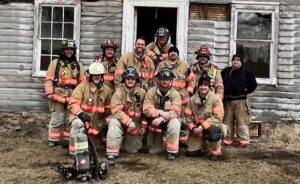
February’s training
In February, they practiced navigating the house and keeping track of one another and the fire hose blindfolded to simulate a house filled with black smoke. They practiced securely hanging from windows and breaking through walls with axes to crawl through, as might be necessary when needing an alternative exit or needing to save a life in a bedroom.

It was quite an education for us to watch that day; and wow, I have so much sincere, tremendous respect for these brave individuals now that I’ve been up close and personal with what they do to serve and protect others. Absolutely incredible and definitely heroic.


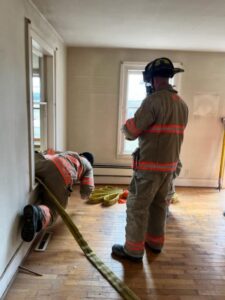
In preparation for the next training, they sent a few men out to remove the glass windows from the house and put boards over the windows with hinges. This served to keep the training fires contained and smoke in the rooms, but allowed for the firefighters to escape easily if needed via a window. They also strategically placed piles of wood and straw bales in different rooms of the house. They planned to light these on fire, one at a time, for different teams to practice going into the home, locating the fire, and extinguishing it.
March’s training
On March 19, we had the Manchester Township Fire Department, Grass Lake Fire Department and Cambridge Township Fire Department all represented. They rolled up on our farm with 3 fire trucks, 2 tanker trucks, an ambulance, several brush trucks, about 30 firefighters–both men and women, a lead instructor, several lieutenants, and the fire chief. And they prepared for additional training.
During the set up, two tanker trucks filled two huge reservoirs, like swimming pools, with water. Between the fire trucks and the reservoirs, approximately 11,000 gallons of water were at the ready, and the tankers were prepared to get more several country roads away if and when that may be needed.
After everyone suited up and was familiar with the house, they temporarily closed the road and began the training. The chief and lieutenants set fires, one at a time, in different rooms with road flares and sent in teams of four to find and extinguish each blaze. One of the lieutenants had a clip board with tags hanging from it to keep track of each person’s location so he knew exactly who was in the house when.

It was both incredible and frightening. We stood in the yard watching as smoke began to stream from the eaves and boarded-up windows, and we stared in amazement and awe as suited-up firefighters bravely and courageously went into the house. We prayed for their protection and safety both in those moments and countless times before this actual day. Thankfully, after each training scenario, all four individuals on each team returned to the front yard safely.
When it was time to let the house be consumed by fire, they told us to evacuate our house and property just across the side yard. We crossed the road to watch by our barns — a safe distance from the flames and smoke for us, our kids, and our dogs. They moved into position surrounding the house, hoses at the ready, with plenty of water on hand. Then we watched.
A slow burn
What we thought would be a quick engulfing of a home, turned out to be a slow burn taking about two hours for the house to come down. Probably for a variety of reasons – one being the well-built quality of the house with all the hardwood, and another being the fact that the wood was wet from having just been soaked with fire hoses putting out fires in many of the rooms. Still, it was quite a sight. Slowly but surely, the humongous flames melted the home to the ground, leaving a pile of ashes.
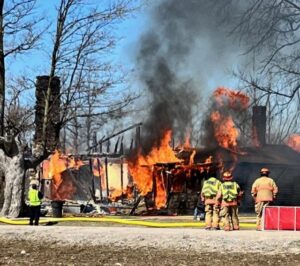
All that’s left standing are two chimneys – the one from the fireplace in the living room and the one from the stove in the kitchen. It looks atrocious right now, but soon we’ll have those knocked down and the yard graded smooth. It’s a process, which doesn’t happen overnight. So to all who drive by: please excuse our mess while we work to make it nice.

What was most incredible to Tom and I was how our newly remodeled and freshly-painted home nearby was untouched and unaffected. The firefighters promised they would do everything in their power to contain the fire and protect all the surroundings. And they did.

We also believe the hand of God was involved. What started off as a cold, sunny March morning, turned into a windy mid-day and afternoon. This meant, when it was time to let the house burn at noon, the winds were blowing at 10-20 mph from West to East, in the direction of our home.
But somehow, the wind either blew southeast or northeast rather than directly East, and the blackened smoke rolled off the burning house and went up and over our home. I was completely in awe of how there appeared to be a shield of protection over our home that the smoke and flames couldn’t penetrate. Thank you, God!

What’s next?
Since moving to the Michigan farm, family and friends often ask, “What’s next on your list of projects?” They ask because they know there’s no shortage of work to be done here, and we’ve already accomplished much. We always have something going – whether it be remodeling the farmhouse, laying a new concrete patio, re-roofing the gambrel barn, pulling old fences, or finishing a room in the basement for our girls.
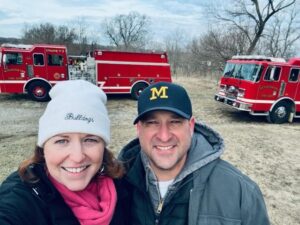
As far as what’s next, we’ve got a Summer of additional clean-up planned. Stay tuned to watch and see! We’re always intentionally up to something to beautify, preserve, or restore where we can.
I hope you’re up to something good as well!
Have comments? Leave them below! Or you’re welcome to email me at yoursintentionally@yahoo.com. I always enjoy hearing from you!
Yours intentionally, Amanda

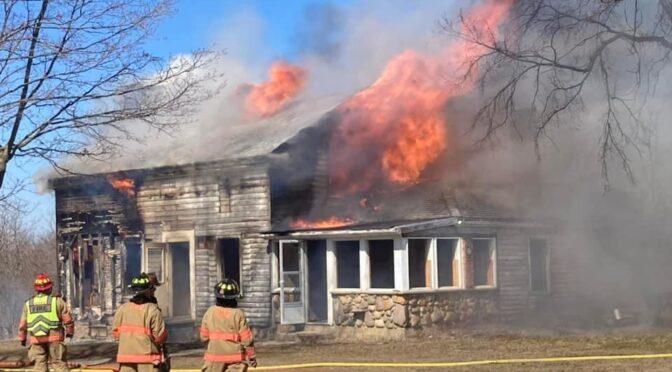
What an amazing, exciting and sad time. Your future is bright. God bless. Charlotte Bentley.
Thank you, Charlotte! We’re excited to see what the future brings!
Amanda you are an amazing writer. I could see the event moment by moment as you described each stage of the training and the burn. It was a bittersweet happening for family. I quit work for two years and worked on updating and remodeling the house starting in 1969. We could do so many things ourselves that we didn’t have to hire done. I learned to do many things. Before any of the work began my mother said who will do the painting you have never painted before? I said when I get done with all of this I will know how. The house project made a cozy, friendly home for our family.
Thank you, Judy! It was fun to capture all the details and share the story. What a memory and experience for our family down the road! I know you poured a lot into the home, and it was lovely when you lived there. Good for you learning new skills back then and being brave enough to take on such a large project yourself.
Since my grandparents and mother, Jean Irwin, lived on the farm and I visited many times as a child and adult I remember it all very well. Corinna shared this article with me and it is excellent. It is hard to believe so much time has passed since I am now 82.
Hi Harriet, Thank you for your comment! It is wonderful to hear about your grandparents and mother. We are piecing together the history and the family members as we learn more and more. Our girls love to learn about all the extended family that either once lived here or visited here throughout its nearly 200-year history!
My mother was the youngest of the 4 kids and when her parents split up and her mother went to work in Battle Creek, she was sent to Chelsea to live with her grandparents, the Lawrences. She was 10 at the time The others stayed on the farm and came to town for school. You may know the Lawrences were Edith’s parents. Yes, I remember going over to that old unoccupied house with Beth and Nancy but Helen Bennett came out to visit that day and saw our fingerprints so we got caught and were warned not to go back there! Later, Donald bought the house from Helen and you know the rest.
Well done, Irwins. I am the baby cousin of my generation, born 1946. As I recall, Mom’s (Jean Irwin Johnsen) cousin Helen Irwin Bennett owned the house as her father Professor Frederick Irwin was the elder son of John Emery Irwin, therefore inherited the house. It was OFF LIMITS to me as a child , but one day, my sly and mischievous cousin Barbie took me for an illicit tour of the home when I was 7 or 8. We didn’t get caught, Barbie was too clever, My memory may fail me, but I recall seeing Lt John Emery Irwin’s Civil War saber. Loved THE FARM!
Hi Eric, Thanks for commenting! I recognize many of the names in your story, and laughed about your adventures with Barbie. I just had the opportunity to meet Barbie this past summer. I absolutely love that so many people have fond memories of the farm and that we can keep the Irwin story going.